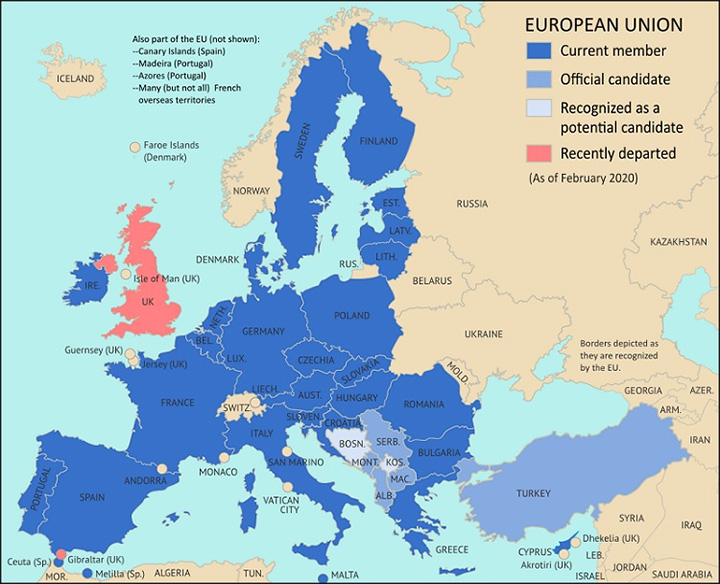Biodiversity & Environment
Fit for 55 Package: EU
- 17 Jul 2021
- 7 min read
Why in News
Recently, the European Union (EU) released a new climate proposal, the Fit for 55 package.
- The EU in December 2020 submitted a revised Nationally Determined Contribution (NDC) under the Paris Agreement.
Key Points
- Aim:
- The new package attempts to deliver the NDC and carbon neutrality goal through proposed changes that would impact the economy, society and industry, as well as ensure a fair, competitive and green transition by 2030 and beyond.
- Climate neutrality is achieved when a country’s emissions are balanced by absorptions and removal of greenhouse gases from the atmosphere. It is also expressed as a state of net-zero emissions.
- It claims to achieve a balance between “regulatory policies” and market-based carbon pricing to avoid the pitfalls of each.
- The new package attempts to deliver the NDC and carbon neutrality goal through proposed changes that would impact the economy, society and industry, as well as ensure a fair, competitive and green transition by 2030 and beyond.
- Major Proposals:
- Renewable Sources:
- It proposes to increase the binding target of renewable sources in the EU’s energy mix to 40% (from 32% earlier) and improve energy efficiency by 36% (from 32.5% earlier) by 2030.
- Vehicular Carbon Emissions:
- It must be cut by 55% by 2030 and by 100% by 2035, which means a phaseout of petrol and diesel vehicles by 2035.
- It also includes some provisions that benefit the auto industry. Public funds will be used to help build charging stations every 60 kilometers, on major highways, a move that will encourage sales of electric cars.
- It will also help finance a network of hydrogen fueling stations.
- Emissions Trading System:
- It calls for the creation of an Emissions Trading System (ETS) for buildings and road transport, separate from the EU’s current ETS, to become operational from 2026.
- ETS are market-based instruments that create incentives to reduce emissions where these are most cost-effective.
- It calls for the creation of an Emissions Trading System (ETS) for buildings and road transport, separate from the EU’s current ETS, to become operational from 2026.
- Social Climate Fund:
- To help low-income citizens and small businesses adjust to the new ETS, the EU proposes the creation of a Social Climate Fund, which will take various forms ranging from funding for renovation of buildings, and access to low carbon transport, to direct income support.
- They expect to build up this fund using 25% of revenues from the new ETS. The current ETS is proposed to extend to the maritime sector between 2023 and 2025.
- Carbon-Border Adjustment Mechanism:
- Among other market-based mechanisms, the EU is proposing a carbon-border adjustment mechanism, which will put a price on imports from places that have carbon-intensive production processes.
- This instrument has been deemed to have a small impact on global carbon dioxide emissions by the United Nations Conference on Trade and Development, and could instead have negative impacts on developing countries.
- Enhance Sink Capacity:
- It has set a target to enhance the EU’s sink capacity to 310 million tonnes of CO2 equivalent, which it hopes will be achieved through specific national targets by member countries.
- Renewable Sources:
- Analysis:
- The EU's NDC target is to reduce greenhouse gas emissions by 55% below 1990 levels by 2030. It has also set a long-term goal of achieving carbon neutrality by 2050.
- The EU’s target is more aggressive than that of the US, which committed to reduce emissions by 40% to 43% over the same period, but behind Britain, which pledged a 68% reduction.
- China, the world’s largest emitter, has only said it aims for emissions to peak by 2030.
- Fit for 55 Package could put Europe at the forefront of new technologies like electric car batteries, offshore wind generation or aircraft engines that run on hydrogen.
- But the transition will also be painful for some consumers and companies, raising the cost of a wide variety of goods and services, like video monitors imported from China, for example, or a vacation flight to a Greek island or even a full tank of gasoline.
- Companies that make products destined for obsolescence, like parts for internal combustion engines, must adapt or go out of business.
- The proposals could reshape polluting industries like steelmaking, which directly employs 330,000 people in the EU.
- The EU's NDC target is to reduce greenhouse gas emissions by 55% below 1990 levels by 2030. It has also set a long-term goal of achieving carbon neutrality by 2050.
India's INDC, to be achieved primarily, by 2030
- To reduce the emissions intensity of the Gross Domestic Product by about a third.
- A total of 40% of the installed capacity for electricity will be from non-fossil fuel sources.
- India also promised an additional carbon sink (a means to absorb carbon dioxide from the atmosphere) of 2.5 to 3 billion tonnes of carbon dioxide equivalent through additional forest and tree cover by the year 2030.
Indian Initiatives to Fight Climate Change:
Way Forward
- The principle of climate justice should guide the negotiations over the package.
- Fit for 55 pushes EU decarbonization into higher gear, marking the visible entry of climate policy into the daily life of all European citizens and companies, and also starting to impact global trade partners.
- Ensuring that the transition is socially fair, both domestically and internationally, is the most important element to make it successful in the long-run.







